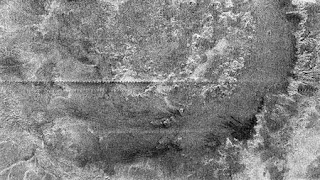 |
| Artistic rendition of Titan’s surface |
Titan, the largest moon of Saturn, is one of our Solar System’s most Earth-like bodies. Many scientists believe that its chemical make-up is probably similar to Earth’s primordial atmosphere with a wide range of organic and inorganic compounds, and liquid hydrocarbon seas and lakes.
We know from the Voyager and Cassini infrared measurements that there is abundant molecular hydrogen in Titan’s atmosphere. A2019 a paper by Lombardo et. al showed that hydrocarbons exist in a wide range of organic and inorganic compounds.
 |
| Figure 1. Neutral C1, C2, and C3 hydrocarbons of Titan's atmosphere and their approximate volume mixing ratios at 200 km derived from Vinatier et al. (2015). Heavier species are not shown. Propyne and propadiene now constitute the first hydrocarbon isomer pair detected on Titan. From Lombardo et.al. |
Now, at the Lunar and Planetary Science Conference 2021, A.P Crósta et. al suggest that particular impact craters on Titan may have allowed the “exchange of materials between the surface, the near subsurface and the ocean, and possibly even created conditions for the development of primitive lifeforms. “
The team modeled the impact for the moon’s largest crater, 425-kilometer-wide Menrva, and the results suggest that the crater was due to a 34-kilometer-wide space rock hitting the surface at 7 kilometers per second.
 |
| Menrva, Titan’s largest crater. NASA |
The heat resulting from the impact would have pierced the surface and a lake would have formed. Due to Titan’s cold temperatures they estimate that it would have existed for 1 million years before freezing over. But this may have been enough time for bacteria to evolve, as liquid water, organic molecules, and heat were available from the impact.
Their conclusion:
Large hypervelocity impacts can have an important and beneficial role in creating habitable environments or niches. When viewed from the perspective of a geobiological process, impact cratering can influence the biological evolution of planetary bodies and control planetary habitability.Our findings include the occurrence of significant exchange of materials from the surface (organics and ice) and the subsurface (water ocean) in the central area of Titan’s Menrva crater. We argue that a combination of these processes, in an environment containing or- ganic compounds and water, heated to ca. 280 K by the transfer of thermal energy from the impact to the crust, would result in a near-optimal habitable ecosystem or a habitable zone on Titan. Thus, Menrva crater and its immediate surrounding terrains, such as the ice-rich regions to the south, southeast and east of the crater offer a potentially favorable location for future explora- tory missions in search for biosignatures.
 |
| An artist's imagination of hydrocarbon pools, icy and rocky terrain on the surface of Saturn's largest moon Titan. Image: European Space Agency |
Tags:
Astronomy
